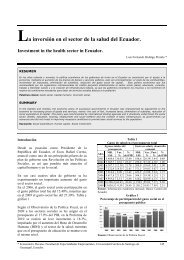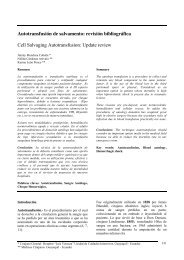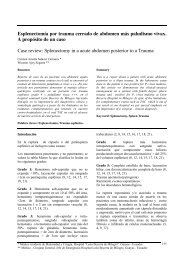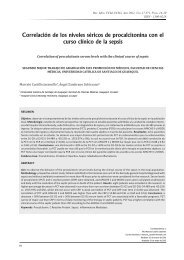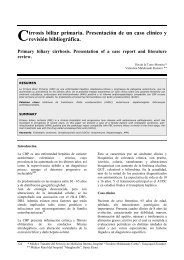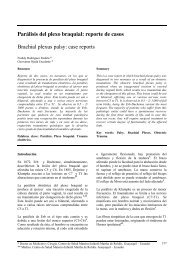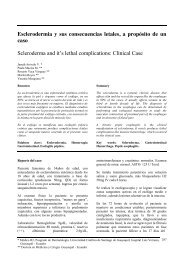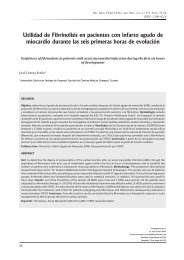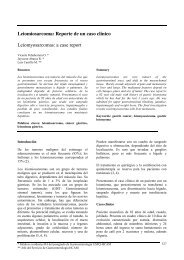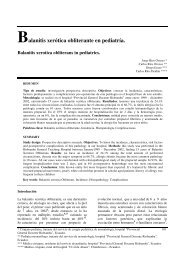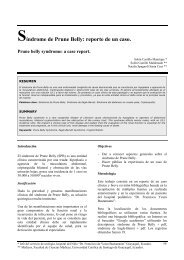El test de la figura humana de Goodenough
El test de la figura humana de Goodenough
El test de la figura humana de Goodenough
Create successful ePaper yourself
Turn your PDF publications into a flip-book with our unique Google optimized e-Paper software.
Característica<br />
Característica<br />
Característica<br />
Característica<br />
Característica<br />
Característica<br />
Característica<br />
Característica<br />
Trastorno <strong>de</strong>l<br />
aprendizaje no<br />
especificado<br />
Trastorno <strong>de</strong><br />
atención con<br />
hiperactividad<br />
<strong>El</strong> <strong>test</strong> <strong>de</strong> <strong>la</strong> <strong>figura</strong> <strong>humana</strong> <strong>de</strong> Goo<strong>de</strong>nough en el diagnóstico <strong>de</strong> patologías psiquiátricas infantiles. Estudio realizado en <strong>la</strong> ciudad <strong>de</strong> Guayaquil.<br />
Tab<strong>la</strong> 2<br />
Características con frecuencia <strong>de</strong> aparición > 70%<br />
en <strong>la</strong>s patologías psiquiátricas, DFH Masculina<br />
Depresión<br />
Ansiedad<br />
Discusión<br />
De acuerdo a <strong>la</strong>s diferencias en <strong>la</strong> frecuencia <strong>de</strong><br />
representación <strong>de</strong> <strong>la</strong>s características, entre<br />
pacientes con patología <strong>de</strong> origen orgánico o<br />
disfuncional, se escogió trabajar con <strong>la</strong>s <strong>de</strong> mayor<br />
presentación. Aquel<strong>la</strong>s que están por encima <strong>de</strong>l<br />
20% en el DFH masculina y <strong>de</strong>l 40% en el DFH<br />
femenina se consi<strong>de</strong>raron <strong>de</strong>terminantes.<br />
11<br />
9<br />
4<br />
1<br />
62*<br />
46<br />
45<br />
44<br />
30<br />
56*<br />
67<br />
55<br />
54<br />
47<br />
39<br />
36<br />
35<br />
29<br />
%<br />
100%<br />
100%<br />
100%<br />
100%<br />
88%<br />
88%<br />
88%<br />
88%<br />
88%<br />
75%<br />
75%<br />
75%<br />
75%<br />
75%<br />
75%<br />
75%<br />
75%<br />
75%<br />
53*<br />
24*<br />
19*<br />
67<br />
55<br />
47<br />
46<br />
36<br />
35<br />
30<br />
18<br />
11<br />
10<br />
9<br />
4<br />
1<br />
%<br />
100%<br />
100%<br />
100%<br />
100%<br />
100%<br />
100%<br />
100%<br />
100%<br />
100%<br />
100%<br />
100%<br />
100%<br />
100%<br />
100%<br />
100%<br />
100%<br />
17*<br />
16*<br />
14*<br />
36<br />
10<br />
1<br />
6*<br />
49*<br />
68*<br />
61*<br />
37*<br />
32*<br />
28*<br />
21*<br />
30<br />
29<br />
%<br />
100%<br />
100%<br />
100%<br />
100%<br />
100%<br />
100%<br />
86%<br />
86%<br />
71%<br />
71%<br />
71%<br />
71%<br />
71%<br />
71%<br />
71%<br />
71%<br />
46<br />
4<br />
1<br />
44<br />
35<br />
11<br />
30<br />
55<br />
47<br />
18<br />
9<br />
%<br />
100%<br />
100%<br />
100%<br />
91%<br />
91%<br />
91%<br />
82%<br />
73%<br />
73%<br />
73%<br />
73%<br />
* Característica única <strong>de</strong> <strong>la</strong> patología.<br />
Fuente: autor.<br />
Tab<strong>la</strong> 3<br />
Características con frecuencia <strong>de</strong> aparición > 70%<br />
en <strong>la</strong>s patologías psiquiátricas, DFH Femenina<br />
Depresión<br />
1<br />
32<br />
%<br />
100%<br />
75%<br />
Trastorno <strong>de</strong>l<br />
Trastorno <strong>de</strong><br />
aprendizaje<br />
atención con<br />
no<br />
hiperactividad<br />
especificado<br />
1<br />
32<br />
%<br />
100%<br />
100%<br />
1<br />
2<br />
3*<br />
4<br />
5*<br />
6*<br />
28*<br />
32<br />
33<br />
34*<br />
* Característica única <strong>de</strong> <strong>la</strong> patología.<br />
Fuente: autor.<br />
%<br />
100%<br />
100%<br />
100%<br />
100%<br />
100%<br />
100%<br />
100%<br />
100%<br />
100%<br />
100%<br />
Ansiedad<br />
1<br />
4<br />
19*<br />
2<br />
13*<br />
24*<br />
33<br />
41*<br />
43*<br />
52*<br />
56*<br />
%<br />
100%<br />
93%<br />
93%<br />
79%<br />
79%<br />
79%<br />
79%<br />
71%<br />
71%<br />
71%<br />
71%<br />
En <strong>la</strong> búsqueda <strong>de</strong> <strong>la</strong>s características particu<strong>la</strong>res<br />
<strong>de</strong> cada patología se trabajó con aquel<strong>la</strong>s que<br />
tenían más <strong>de</strong>l 70% <strong>de</strong> frecuencia <strong>de</strong> aparición; y,<br />
aquel<strong>la</strong>s con una baja representación, es <strong>de</strong>cir, por<br />
<strong>de</strong>bajo <strong>de</strong>l 25% con <strong>la</strong> intención <strong>de</strong> i<strong>de</strong>ntificar <strong>la</strong><br />
no presencia <strong>de</strong> características que tuvieran algún<br />
grado <strong>de</strong> coinci<strong>de</strong>ncia con el cuadro patológico.<br />
En el análisis <strong>de</strong> <strong>la</strong> re<strong>la</strong>ción entre el dibujo y el<br />
origen <strong>de</strong> <strong>la</strong> patología, y los cuadros clínicos<br />
reportados, <strong>la</strong>s características que se observaron<br />
con mayor frecuencia fueron <strong>la</strong>s correspondientes<br />
al grupo <strong>de</strong> <strong>la</strong> cabeza, específicamente los rasgos<br />
que componen su expresión o que <strong>la</strong><br />
complementan, y <strong>la</strong>s extremida<strong>de</strong>s.<br />
Estos resultados no nos sorpren<strong>de</strong>n puesto que<br />
confirman lo hal<strong>la</strong>do en <strong>la</strong> literatura. La cabeza es<br />
<strong>la</strong> localización central <strong>de</strong>l propio yo, <strong>de</strong>l dominio<br />
<strong>de</strong>l entorno social, intelecto e impulsos <strong>de</strong>l<br />
cuerpo 9 . <strong>El</strong> niño podrá <strong>de</strong>jar <strong>de</strong> dibujar cualquier<br />
parte <strong>de</strong>l cuerpo, pero <strong>la</strong> cabeza,<br />
in<strong>de</strong>pendientemente <strong>de</strong> su forma y tamaño, va a<br />
estar por lo general siempre dibujada llegando a<br />
constituir todo el dibujo 9 . Dentro <strong>de</strong> <strong>la</strong> cabeza está<br />
<strong>la</strong> cara que se encarga <strong>de</strong> <strong>la</strong> comunicación 9 . Ésta<br />
posee elementos que componen su expresión y<br />
que complementan el significado <strong>de</strong>l dibujo. Las<br />
extremida<strong>de</strong>s por otro <strong>la</strong>do son los elementos que<br />
nos llevan al contacto; cada estructura que <strong>la</strong><br />
integra es fundamental para re<strong>la</strong>cionarnos<br />
íntimamente con el ambiente 9 . Lo mencionado<br />
explica el porqué estas características son parte<br />
fundamental <strong>de</strong>l dibujo. Es a través <strong>de</strong> éstas, que<br />
el individuo se expresa ante el mundo y entra en<br />
contacto directo con él. Sin estas partes no habría<br />
una verda<strong>de</strong>ra expresión <strong>de</strong>l dibujo, el cual indica<br />
no so<strong>la</strong>mente el pensamiento <strong>de</strong>l individuo que lo<br />
dibuja, sino también sus ansieda<strong>de</strong>s, conflictos,<br />
impulsos y <strong>la</strong> percepción <strong>de</strong>l medio que lo ro<strong>de</strong>a 9 .<br />
A pesar que <strong>de</strong>ntro <strong>de</strong> los datos obtenidos <strong>la</strong>s<br />
características pertenecientes a los grupos <strong>de</strong>:<br />
proporciones, perfil, líneas y formas dirigidas,<br />
frente, vestimenta y atavío, están <strong>de</strong>ntro <strong>de</strong> los<br />
101




